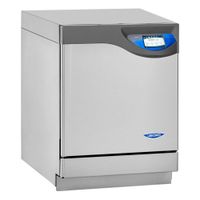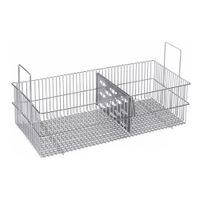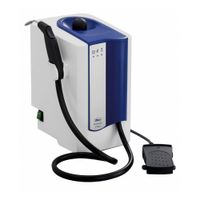Call +(254) 703 030 000 / 751 483 999 / 721 704 777
- Home
- Lab Supplies
- Lab Equipment
- Lab Cleaning Equipment
.....Read More
Frequently Asked Questions
What is ultrasonic cleaning and how does it work?
Ultrasonic cleaning is a process that uses high-frequency sound waves, typically between 20 kHz and 400 kHz, to agitate a fluid. This agitation produces high forces on contaminants adhering to substrates like metals, plastics, glass, rubber, and ceramics. The ultrasonic cleaning process involves immersing the items to be cleaned in a tank filled with a suitable cleaning solution, often water-based with added detergents.
The core mechanism of ultrasonic cleaning is cavitation. When ultrasonic waves pass through the liquid, they create compression and rarefaction cycles. During the rarefaction cycle, small vacuum bubbles form in the liquid. These bubbles grow over successive cycles until they reach a size where they can no longer absorb energy and collapse violently during the compression cycle. This collapse, or implosion, generates intense localized pressure and temperature, creating micro-jets that dislodge contaminants from the surface of the items being cleaned.
Ultrasonic cleaning is effective for removing dirt, dust, grease, and other deposits from intricate and hard-to-reach areas, making it ideal for cleaning complex parts like jewelry, medical instruments, electronic components, and automotive parts. The process is gentle enough to clean delicate items without causing damage, yet powerful enough to remove stubborn contaminants.
The efficiency of ultrasonic cleaning depends on several factors, including the frequency of the ultrasonic waves, the temperature of the cleaning solution, the type of cleaning solution used, and the duration of the cleaning process. Adjusting these parameters can optimize the cleaning process for different types of contaminants and materials.
How do I choose the right ultrasonic cleaner for my lab?
To choose the right ultrasonic cleaner for your lab, consider the following factors:
1. **Size and Capacity**: Determine the size of the items you need to clean and choose a cleaner with an appropriate tank size. Ensure it can accommodate the largest items you plan to clean.
2. **Frequency**: Select a cleaner with the right frequency for your cleaning needs. Lower frequencies (25-40 kHz) are suitable for heavy-duty cleaning, while higher frequencies (above 40 kHz) are better for delicate items.
3. **Power**: Consider the power output, measured in watts. Higher power provides more intense cleaning but can be harsh on delicate items. Balance power with the fragility of the items.
4. **Tank Material**: Choose a tank made of durable materials like stainless steel to withstand the cleaning process and ensure longevity.
5. **Heating Element**: A built-in heater can enhance cleaning efficiency by loosening contaminants. Decide if you need a model with adjustable temperature settings.
6. **Timer and Controls**: Look for models with adjustable timers and user-friendly controls for precise cleaning cycles.
7. **Degassing Feature**: This feature removes air bubbles from the cleaning solution, improving cleaning efficiency, especially for intricate items.
8. **Solution Compatibility**: Ensure the cleaner is compatible with the cleaning solutions you intend to use, considering chemical resistance and effectiveness.
9. **Brand and Warranty**: Opt for reputable brands known for quality and reliability. Check the warranty and customer support options.
10. **Budget**: Balance your needs with your budget, considering both initial costs and long-term maintenance.
11. **Noise Level**: Consider the noise level if the cleaner will be used in a shared or quiet environment.
Evaluate these factors based on your specific lab requirements to select the most suitable ultrasonic cleaner.
What are the benefits of using ultrasonic cleaners over traditional cleaning methods?
Ultrasonic cleaners offer several advantages over traditional cleaning methods:
1. **Efficiency**: Ultrasonic cleaners use high-frequency sound waves to create microscopic bubbles in a cleaning solution. These bubbles implode, producing a scrubbing action that cleans surfaces and crevices more thoroughly and quickly than manual scrubbing.
2. **Precision**: They can clean intricate and delicate items, such as jewelry, medical instruments, and electronic components, without causing damage. The gentle yet effective cleaning action reaches areas that are difficult or impossible to clean manually.
3. **Consistency**: Ultrasonic cleaning provides uniform cleaning results, ensuring that every part of the item is cleaned to the same standard, which is often challenging to achieve with manual methods.
4. **Time-Saving**: The process is automated and requires minimal supervision, freeing up time for other tasks. It also reduces the need for pre-soaking or multiple cleaning cycles.
5. **Chemical Reduction**: Ultrasonic cleaners often require fewer harsh chemicals, as the mechanical action of the bubbles enhances the cleaning power of milder solutions, making it a more environmentally friendly option.
6. **Versatility**: They can clean a wide range of materials and items, from metals and plastics to glass and ceramics, making them suitable for various industries, including healthcare, automotive, and manufacturing.
7. **Safety**: Reduces the need for manual handling of potentially hazardous cleaning agents and sharp or delicate items, minimizing the risk of injury.
8. **Cost-Effective**: Although the initial investment may be higher, the reduction in labor, cleaning agents, and time can lead to cost savings in the long run.
9. **Non-Invasive**: The non-abrasive nature of ultrasonic cleaning preserves the integrity and longevity of items, especially important for antiques and sensitive equipment.
How often should lab glassware be cleaned using ultrasonic cleaners?
The frequency of cleaning lab glassware using ultrasonic cleaners depends on several factors, including the type of experiments conducted, the nature of the substances used, and the level of cleanliness required. Generally, ultrasonic cleaning is recommended when:
1. **After Each Use**: For glassware used with sticky, oily, or hard-to-clean substances, ultrasonic cleaning after each use ensures thorough removal of residues that manual cleaning might miss.
2. **Routine Maintenance**: For glassware used in routine experiments with less aggressive chemicals, ultrasonic cleaning can be scheduled weekly or bi-weekly as part of regular maintenance to prevent buildup of residues.
3. **Before Critical Experiments**: Prior to conducting sensitive or critical experiments, ultrasonic cleaning ensures that the glassware is free from any contaminants that could affect results.
4. **When Visible Residues Are Present**: If glassware shows visible residues or stains that are difficult to remove manually, ultrasonic cleaning should be employed immediately.
5. **For Sterilization**: In cases where sterilization is crucial, such as in microbiology or cell culture labs, ultrasonic cleaning can be part of the sterilization process, followed by autoclaving.
6. **For Delicate Glassware**: Fragile or intricately shaped glassware that is difficult to clean manually can benefit from more frequent ultrasonic cleaning to ensure all areas are reached without risk of breakage.
Ultimately, the decision on how often to use ultrasonic cleaners should be based on the specific requirements of the laboratory, the nature of the experiments, and the level of cleanliness needed to ensure accurate and reliable results. Regular assessment of the cleaning process and adjustments based on the condition of the glassware and experimental outcomes are advisable.
Can ultrasonic cleaners be used for all types of lab equipment?
Ultrasonic cleaners are versatile devices that use high-frequency sound waves to agitate a fluid, effectively cleaning items submerged in the solution. However, they are not suitable for all types of lab equipment.
Ultrasonic cleaners are ideal for cleaning glassware, metal instruments, and certain types of plastic equipment. They are particularly effective for items with complex shapes or intricate parts, such as pipettes, beakers, and surgical instruments, where manual cleaning might miss hidden contaminants. The cavitation process in ultrasonic cleaning can reach into small crevices and remove residues that are difficult to eliminate by other means.
However, there are limitations. Delicate items, such as thin glass or certain electronic components, may be damaged by the intense vibrations. Some materials, like soft plastics or certain types of rubber, may degrade or become discolored. Additionally, ultrasonic cleaning is not suitable for items that are sensitive to water or the cleaning solution used, such as certain electronic devices or components that are not waterproof.
Furthermore, ultrasonic cleaners should not be used for equipment that contains adhesives, as the vibrations can weaken or dissolve the adhesive bonds. Items with painted surfaces or coatings may also be at risk, as the cleaning process can strip or damage these finishes.
In summary, while ultrasonic cleaners are highly effective for many types of lab equipment, they are not universally applicable. It is crucial to consider the material and construction of the equipment, as well as the compatibility of the cleaning solution, to ensure that ultrasonic cleaning is appropriate and will not cause damage. Always consult manufacturer guidelines and conduct a risk assessment before using an ultrasonic cleaner on any lab equipment.
What maintenance is required for ultrasonic cleaning equipment?
Maintenance of ultrasonic cleaning equipment involves several key steps to ensure optimal performance and longevity:
1. **Regular Cleaning**: Clean the tank regularly to prevent residue buildup. After each use, drain the tank and wipe it down with a soft cloth. Use a mild detergent if necessary, but avoid abrasive materials that could damage the tank.
2. **Solution Replacement**: Change the cleaning solution frequently. The effectiveness of the solution diminishes with use, and contaminants can accumulate, reducing cleaning efficiency.
3. **Inspect Transducers**: Regularly check the transducers for signs of wear or damage. Transducers are critical for generating ultrasonic waves, and any malfunction can impair cleaning performance.
4. **Check Electrical Components**: Inspect electrical connections and components for signs of wear or damage. Ensure that all connections are secure and that there are no exposed wires.
5. **Monitor Temperature**: Ensure that the heating elements are functioning correctly if the unit has a heating feature. Overheating can damage both the equipment and the items being cleaned.
6. **Degas the Solution**: Before using a new cleaning solution, run the unit without any items in it to degas the solution. This removes trapped air and enhances cleaning efficiency.
7. **Calibration**: Periodically calibrate the equipment to ensure it is operating at the correct frequency and power levels. This may require professional servicing.
8. **Check for Leaks**: Regularly inspect the unit for any signs of leaks, particularly around seals and gaskets. Address any leaks promptly to prevent damage.
9. **Follow Manufacturer Guidelines**: Adhere to the maintenance schedule and guidelines provided by the manufacturer. This includes any specific cleaning agents or procedures recommended for your model.
10. **Professional Servicing**: Schedule regular professional maintenance to address any technical issues and ensure the equipment is in top condition.
How do steam jet cleaners differ from ultrasonic cleaners in lab settings?
Steam jet cleaners and ultrasonic cleaners are both used for cleaning in lab settings, but they operate on different principles and are suited for different applications.
Steam jet cleaners use high-temperature steam to clean surfaces. The steam is generated by heating water to a high temperature, which is then directed through a nozzle at high pressure. This method is effective for removing grease, oils, and other contaminants from surfaces. It is particularly useful for cleaning equipment that can withstand high temperatures and moisture. Steam cleaning is environmentally friendly as it typically requires no chemicals, relying solely on the power of steam to sanitize and clean.
Ultrasonic cleaners, on the other hand, use high-frequency sound waves to agitate a cleaning solution, creating cavitation bubbles. These bubbles implode upon contact with surfaces, effectively removing dirt, grime, and other contaminants. Ultrasonic cleaning is gentle and precise, making it ideal for cleaning delicate items such as glassware, electronic components, and intricate lab instruments. It is effective at reaching crevices and areas that are difficult to clean manually. Ultrasonic cleaners often use a combination of water and a mild detergent to enhance cleaning efficiency.
In summary, steam jet cleaners are best for robust cleaning tasks where high heat and moisture are not an issue, while ultrasonic cleaners are preferred for delicate, intricate, or sensitive items that require gentle yet thorough cleaning. The choice between the two depends on the specific cleaning requirements, the nature of the items being cleaned, and the desired level of precision.




